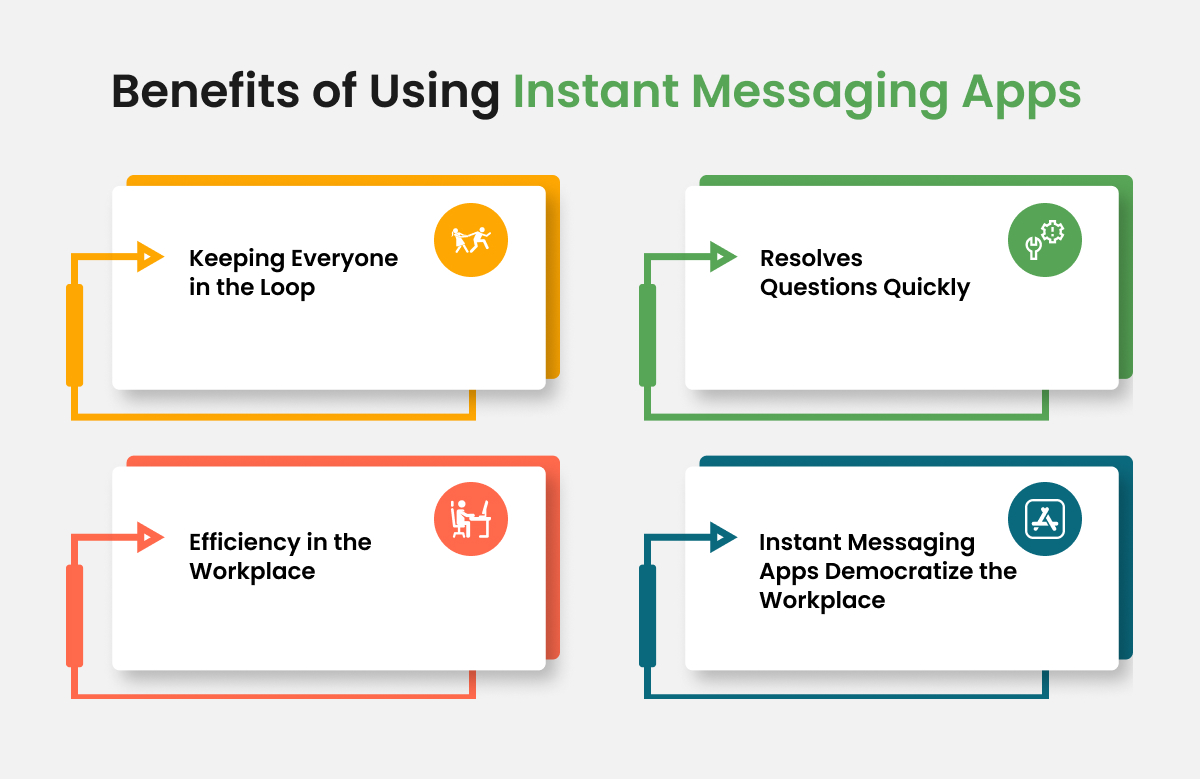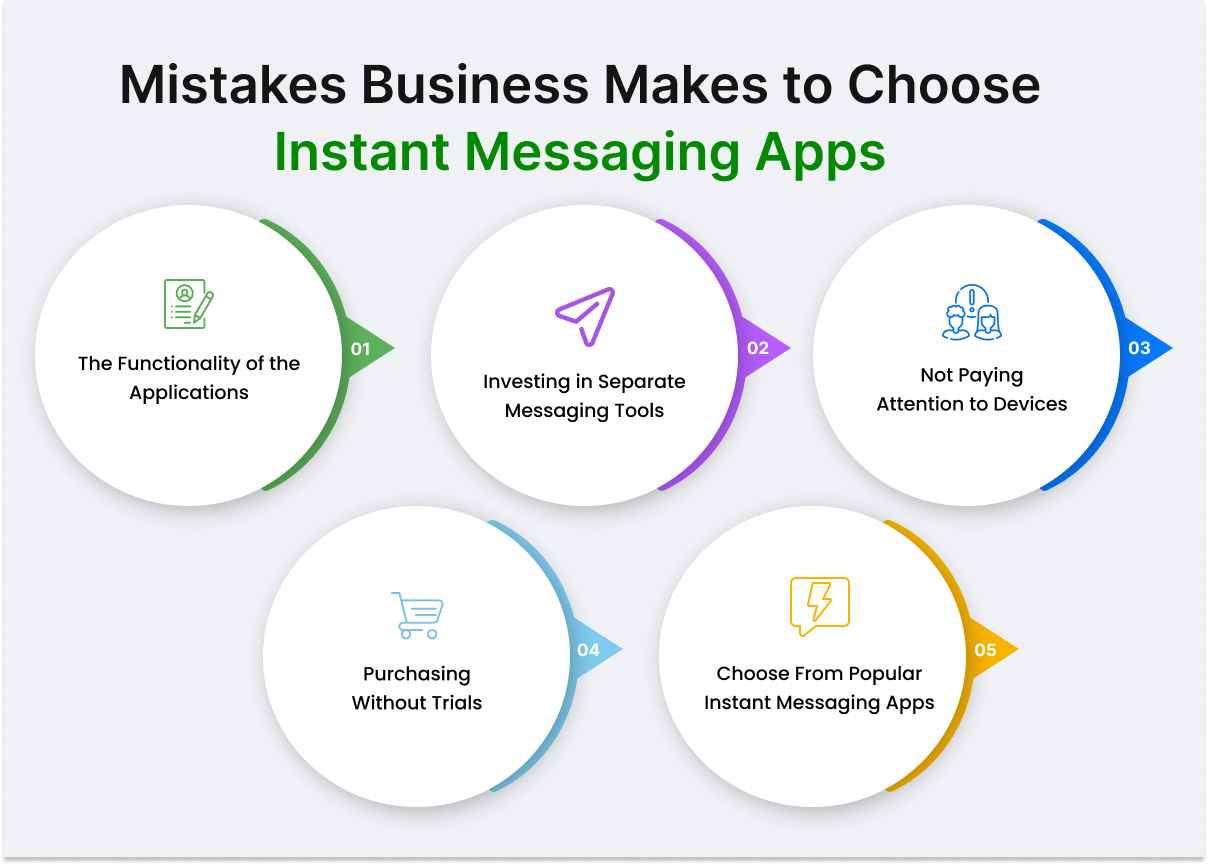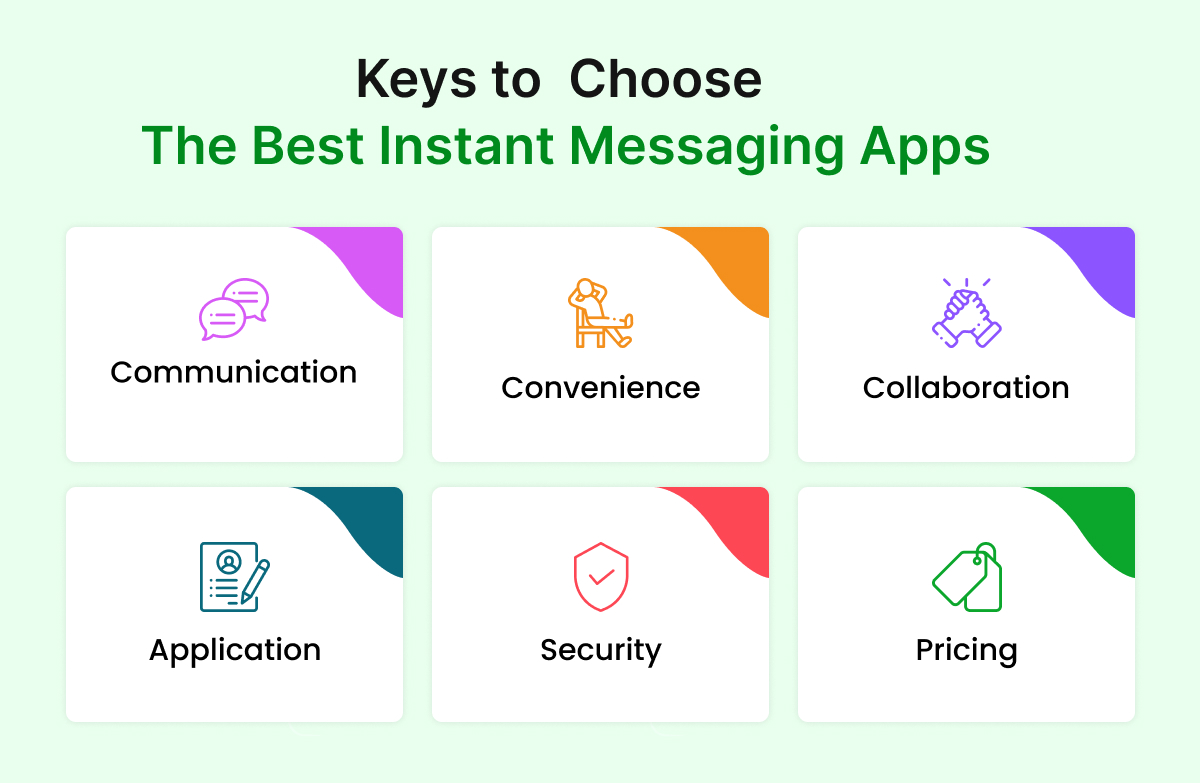 Customer Support
Customer Support

04 March, 2023

Communication and teamwork are the foundation of any successful business. Team members may interact in various ways, but today’s professionals don’t want to be bombarded with emails. So, instant messaging apps ascended in popularity and repudiated the entire business communication channel.
Instant messaging apps were once the exclusive realm of tech geeks. Yet, the manner of communication is now ubiquitous. Fancy a catch-up with your SDRs? Just pick up the phone and tap into a social media platform. Have some questions about a product? You’ll most likely go to the seller’s website and convey the questions over an online chat session.
So what exactly are these instant messaging apps, and which ones are the best for your business?
Read on to discover the most secure instant messaging apps for your organization.
Contents
Before the pandemic, instant messaging apps for businesses were more of a luxury. However, the global pandemic changed everything. According to Statista, over 70% of working professionals are reported to use messaging and chat apps regularly. In fact, business instant messaging apps have become a requisite in every company’s arsenal.
Usually, these apps allow businesses to communicate with clients and team members via desktop or mobile phones. Compared to emails, these platforms provide a faster way to connect and include multiple bonuses like:
If you look at the notifications you received on your phone, chances are most came from popular instant messaging apps. Sure, the utility of these tools skyrocketed in the work-from-home era. But today, in-office teams promptly use them because it makes team communication so convenient.
Here are some examples of how businesses use corporate instant messaging apps:
Let’s check out some of the benefits of instant messaging apps:

Today, 63% of high-growth business models embrace a hybrid work model in which employees work part-time from offices and partially from home. In this structure, it’s usual for messages to slip through the cracks. But that’s where instant messaging applications come in handy. Even if employees are not physically present in the office, the messages can get across to them through instant messaging (IM).
Instead of back-and-forth email chains, IM brings all stakeholders together in one place for real-time action. Rather than sifting through various email threads and waiting for responses that might take hours, instant messaging apps keep things steady and rapid.
Let’s hear it! There is more to IM applications than casual conversations. The good news is that it’s an excellent place to get your questions answered fast.
Instant messaging is also nifty if you work as a support call agent. Instead of putting the clients on hold, you can ping the team members for immediate queries.
Instant messaging apps for businesses are chary because they are the medium for immediate interaction. Because most people don’t scan their email boxes all day but are readily available on their phones or PCs, the speedy delivery with a ting gives you an edge.
The most significant advantage of instant messaging applications is that discussions become more efficient. How? Because messages on these platforms aren’t temporary, you can review or assess them later. According to the latest studies, companies that used IM boosted their productivity by 21%.
IM has allowed the corporate world to become more democratic by ensuring the inclusivity of people working in different locations or time zones. Instant messaging can help organizations create an environment of accountability, trust, and open dialogue. Sharing half-formed ideas for others to build upon, regardless of their business titles, is an excellent way to rouse innovation in the office.
Messaging isn’t ephemeral, unlike calls and meetings. The permanence makes ideas tangible, authentic, and shareable with anyone on board.
Let’s discover how IM applications have become conducive for businesses:
Instant messaging applications enable users to directly message another user, providing straightforward access and information exchange.
Ever thought about bringing your entire team under one roof? Conference rooms are expensive and hectic schedules prevent people from having similar timetables. And for overseas or freelance workers, the issue is more pressing.
But if you had a big plan to reveal, why not leverage instant messaging apps to deliver your message? It’s fast, free, and makes group collaboration a breeze. The pin feature also lets you mark prominent notes in case anyone missed them in the sea of conversation.
Gathering people for a meeting has become a thing of the past. Fixing a date, booking a venue, inviting guests, arranging the place—setting up meetings and conferences can be overwrought and tiring.
Thanks to modern technology, there’s an easy fix. Instant messaging apps like Zoom and Google Meet can connect over 100 people in a video conversation. You can transform the online experience into reality with collaboration tools like file sharing and whiteboards. Most applications also feature enterprise-grade security to ensure maximum privacy for discussions.
The cost-effectiveness of IM applications is perhaps the most substantial benefit. IM services can replace traditional forms of communication, including face-to-face meetups. With video call services, you can maintain a consistent conversation with a prospect in another part of the world while avoiding the high traveling costs.
And from a customer service perspective, online messaging negates the need for expensive mobile plans to address client queries.
Instant messaging tools can synchronize messages across all devices using one account. It can be a lifesaver for organizations when there’s an emergency for crucial projects or deadlines.
Usually, there are two types of instant messaging apps available:
Public forums were strictly avoided on business, given their susceptibility to cyberattacks. But long gone are the days of privacy invasion. Many instant messaging apps have employed cutting-edge technology and introduced end-to-end encryption for every message sent. This means third parties cannot encrypt the data and won’t be able to recover the information sent and received.
Twitter and SMS have taught us to express more with fewer words. Instant messaging, through its functionality, nudges short and concise messages. No one wants to trawl through a series of long emails or take long, unnecessary calls. Instant messaging apps can just be the antidote for communication fatigue.
It’s no secret that some of your sent emails were never opened. There’s a good chance those emails ended up in the spam folder. But IM applications end the issue and guarantee the reception of your messages.
“Okay. ” “Send it over.”
“Okay. “Send it over ?.”
The examples look a whole lot different, don’t they? We can’t decipher the sender’s emotion while reading the first sentence. Are they angry, neutral, frustrated, or optimistic?
However, the second example diminishes the uncertainty with an emoji that conveys amiability.
The example is supported by research showing emojis generate more emotional impact and positivity than regular texts. The study further shows three of the most commonly used emojis:
?–68.8% of people perceive emojis as neutral.
?–75% of people find the emoji positive.
?–62.5% of people find the emoji negative.
There’s nothing new here, but think of how they enhance the quality of your communication.
What is organizational agility? In general terms, organizational agility is the response efficiency businesses have during a crisis or time of uncertainty. It reflects how well companies acclimate to a critical situation.
But what does IM service have to do with organizational agility? Agility can be enhanced by two options:
Instant messaging apps for businesses positively impacts both characteristics, allowing team members to share timely and accurate information regarding organizational issues. Industries become more agile and better prepared to meet administrative demands when circulation is smooth.

Let’s face it! You’ve got plenty of options if you are scouring for IM applications. But it’s important to mention that not all IM apps are designed to be association tools.
For instance, video calls and group chats are superb—but what about file sharing? Don’t forget that these tools are essential for your business hierarchy, meaning they should integrate smoothly with other mechanisms to streamline your business.
The average remote worker answers dozens of emails between group chats and video calls. And for sharing, they use Google Drive.
That’s a lot of tools and windows to be juggling. Even someone highly trained in project management skills finds it arduous. Your best bet? Find a one-size-fits-all corporate instant messaging app. Not only does it make things simpler, but it’s also more comfortable for you to track your data.
And then there’s the price. Which one do you think is cheaper? A unified tool with all built-in features or 4-5 disparate tools? Think about receiving only one invoice instead of a stack of receipts every month.
The best instant messaging apps are accessible from both computers and mobiles. However, not every platform has this trait. So, verify whether the tools work across PC, Mac, iOS, and Android.
This is pretty self-explanatory. Always test the applications before purchasing or subscribing to the pro version.
When trying out the free trial, let your folks try it. They may have specific requirements or require spech functionality. Just give your team access to the sandbox and keep the exploration running.
Popular channels like Messenger or Skype are fantastic but barely suitable for business communication.
As a consumer product, there’s nothing wrong with them. The applications are completely free and extremely useful. And if you are a business of 4-5 people, you can get away with these applications for instant messaging.
However, if you are scaling up, you’ll need third-party integrations through these applications. Will consumer apps become good collaboration tools? In most cases, the answer is a big no.
We’ve analyzed the most popular instant messaging apps and compiled some criteria to spot the best ones:

How does the tool handle communication in the workplace? Does it allow you to chat with prospects externally? Some applications, especially instant messaging apps for PCs, focus on internal communication. However, if you are skyrocketing, use a channel for external and internal communication.
Tricky tools will curtail deployment and acceptance of the application by your team. Instant messaging apps for businesses shouldn’t have a complicated learning curve. You want your business to grow with it, so you want something that has a simple user interface.
Corporate instant messaging apps aren’t just about talking or chatting about the latest trends. Instead, it should harbor an interface that delivers a platform for collaboration among your team to work on different assignments, share files, etc.
The design of the application matters even in the workplace. Employees are used to operating well-designed tools in their personal lives and expect the same in their professional lives.
A fun-filled instant messaging app for work with a modern UI is something you really need to invest in.
If you’re purchasing an instant messaging tool, make sure it’s safe from cyberattacks. As organizations choose the platform to consult their plans and products, the IT department must ensure that all conversations remain confidential from hackers or prying eyes.
While most business software costs big bucks, having a fair pricing plan is critical for instant messaging apps. If you pick something you can’t afford over time, it will be problematized to change in the future.
Now, it’s time for the big reveal. Hold on tight as we run you through our top picks for instant messaging apps:
Slack is a popular choice for businesses that want to employ instant messaging apps. It’s the ultimate solution for a fast-paced working environment and empowers you to tailor its performance based on your business needs.
Slack provides a platform for real-time communication and is accessible on mobiles, computers, Androids, and iOS devices. You can sync the same account across multiple devices to access all your information anytime. The application also integrates with other business services like Gmail and Outlook and features a friendly UX, convenient for users with zero tech knowledge.
Here’s why most businesses today are employing Slack:
Slack offers the ability to hold voice and video calls. You can also create group conversations for specific audiences. Depending on your criteria, you can keep the conversation private or public.
Under Salesforce, Slack offers robust security and protects the conservations 24 hours a day. Further, you can integrate the application with third-party platforms like Google Drive and Office 365 and conceal your data from potential hackers.
There are many ways you can customize the app. You can add emojis to your messages for a unique touch and use hashtags to sort and identify your messages. The software also lets you set notifications for specific keywords. The built-in Workflow Builder can also automate routine tasks by launching custom workflows without complicated steps.
Microsoft Teams is a powerful instant messaging app that supports large-scale and international businesses. It’s available in 181 markets and 53 languages, so you can connect with clients, remote workers, freelancers, and more across different countries. The application is straightforward and user-friendly and keeps large and small teams unified. Due to its advanced security settings, Teams is one of the most secure instant messaging apps.
Here’s why companies should use Microsoft Teams as their go-to approach:
Microsoft Teams offers a versatile chat channel along with voice and video calls. While chat is strictly internal, video calls are for everybody.
With the built-in calendar feature, you can organize employees’ time, especially by planning video conferences on the platform.
The standalone platform has a clean and modern interface and is derivable across platforms. Regardless of the device you use, Teams is available as a native app.
Brosix is a versatile business solution featuring robust security, dynamic productivity tools, and comprehensive administrative control. The voice and video capabilities, screen sharing, and built-in whiteboard streamline communication and collaboration.
You can use the service for the following reasons:
The instant messaging app is compatible across multiple channels like Android, iOS, Mac, Linux, Windows, and the Web.
Employing the tool, users can tailor shared chat spaces and contact lists, establish individual data security, and authorize multiple team admins for an optimized operation.
All communications on this platform are encrypted. Further, you can bolster the peer-to-peer connection with antivirus and malware integration.
The business application is an excellent choice for firms with the will to tailor their necessities. With unlimited integrations with applications like Zoom, HubSpot, Salesforce, and Google Drive, users have the world of functionality at their fingertips.
The application made our list because:
The platform delivers multiple chat channels besides voice and video calling through third-party apps.
Since the instant messaging app was developed for a highly regulated industry, the tool features security options like end-to-end encryption and multifactor authentication.
Trello is a user-friendly tool that lets you organize any tasks or projects into boards and cards for easy access. The application makes your work manageable with Trello cards, where you can assign tasks to your team members.
The application made our list because
You can automate any action on the platform with a single click. You can customize activities on the Trello board or move any task forward without the hassle of manual labor.
Trello is solidly a highly-rated mobile app. You can use the application to do anything you want on the PC. So, you can always stay in the loop even if you don’t have a PC.
Choosing the right instant messaging app for your business can determine the difference between a productive workforce and a non-productive one. Combining them with other corporate tools offers seamless collaboration and management. The software you pick should be fully based on your company’s needs. You can’t go wrong with any of the tools mentioned above. But we recommend checking them out before putting them into action. Till then, happy texting!